IPSec - Configuración de modo comodín, precompartida y de PIX a Cisco VPN Client con autenticación extendida
Contenido
Introducción
Este ejemplo de configuración muestra cómo conectar un VPN Client a un PIX Firewall usando comodines, mode-config, el comando sysopt connection permit-ipsec y la autenticación extendida (Xauth).
Para ver la configuración TACACS+ y RADIUS para PIX 6.3 y posteriores, consulte Ejemplo de Configuración de TACACS+ y RADIUS para PIX 6.3 y PIX/ASA 7.x.
El cliente VPN admite el estándar de cifrado avanzado (AES) como algoritmo de cifrado en Cisco VPN Client versión 3.6.1 y posteriores y con PIX Firewall 6.3. VPN Client soporta tamaños de clave de 128 bits y 256 bits solamente. Para obtener más información sobre cómo configurar AES, consulte Cómo Configurar Cisco VPN Client a PIX con AES.
Consulte Ejemplo de Configuración de Autenticación de PIX/ASA 7.x y Cisco VPN Client 4.x para Windows con Microsoft Windows 2003 IAS RADIUS para configurar la conexión VPN de acceso remoto entre un Cisco VPN Client (4.x para Windows) y el PIX 500 Series Security Appliance 7.x usando un servidor RADIUS de Servicio de Autenticación de Internet (IAS) de Microsoft Windows 2003.
Consulte Ejemplo de Configuración de IPsec entre un Concentrador VPN 3000 y un Cliente VPN 4.x para Windows que usa RADIUS para la Autenticación de Usuario y la Configuración de Contabilización para establecer un túnel IPsec entre un Concentrador VPN 3000 de Cisco y un Cliente VPN 4.x de Cisco para Windows que usa RADIUS para la autenticación y contabilidad de usuario.
Consulte Configuración de IPsec entre un Cisco IOS Router y un Cisco VPN Client 4.x para Windows Usando RADIUS para la Autenticación de Usuario para configurar una conexión entre un router y Cisco VPN Client 4.x usando RADIUS para la autenticación de usuario.
Prerequisites
Requirements
No hay requisitos específicos para este documento.
Componentes Utilizados
La información que contiene este documento se basa en las siguientes versiones de software y hardware.
-
Cisco VPN Client 4.x Este producto cuenta con funciones avanzadas de VPN, a diferencia de Cisco Secure VPN Client 1.x.
-
Firewall PIX 515E versión 6.3(3).
Nota: La tecnología de cifrado está sujeta a controles de exportación. Es su responsabilidad conocer la ley relativa a la exportación de tecnología de cifrado. Para obtener más información, consulte el sitio ![]() de la Oficina de Administración de Exportaciones. Si tiene alguna pregunta acerca del control de las exportaciones, envíe un correo electrónico a export@cisco.com.
de la Oficina de Administración de Exportaciones. Si tiene alguna pregunta acerca del control de las exportaciones, envíe un correo electrónico a export@cisco.com.
The information in this document was created from the devices in a specific lab environment. All of the devices used in this document started with a cleared (default) configuration. If your network is live, make sure that you understand the potential impact of any command.
Convenciones
Antecedentes
El comando sysopt connection permit-ipsec permite implícitamente que cualquier paquete que provenga de un túnel IPsec omita la verificación de un comando access-list, conduit o access-group asociado para las conexiones IPsec. Xauth autentica al usuario IPSec hacia un servidor externo TACACS+ o RADIUS. Además de la clave previamente compartida comodín, el usuario debe proporcionar un nombre de usuario/contraseña.
Un usuario con un cliente VPN recibe una dirección IP de su ISP. Esto se reemplaza por una dirección IP del conjunto de direcciones IP en el PIX. El usuario puede acceder a todo el contenido del escudo de protección, incluidas las redes. Los usuarios que no ejecutan VPN Client pueden conectarse solamente al servidor web usando la dirección externa proporcionada por la asignación estática.
Configurar
En esta sección encontrará la información para configurar las funciones descritas en este documento.
Nota: Use la Command Lookup Tool (sólo clientes registrados) para obtener más información sobre los comandos utilizados en este documento.
Diagrama de la red
En este documento, se utiliza esta configuración de red:
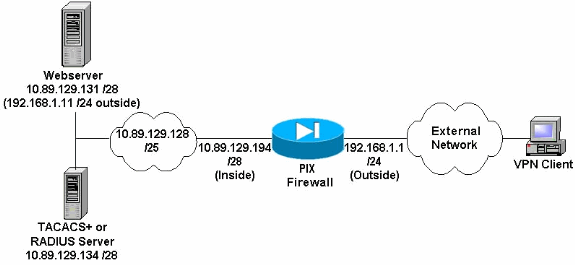
Notas del diagrama de la red
-
Los hosts de Internet que acceden al servidor web utilizando la dirección IP global 192.168.1.1 se autentican incluso si no se establece una conexión VPN. Este tráfico no está cifrado.
-
Los clientes VPN pueden acceder a todos los hosts de la red interna (10.89.129.128/25) una vez que se haya establecido su túnel IPsec. Todo el tráfico del VPN Client al PIX Firewall está cifrado. Sin un túnel IPsec, sólo pueden acceder al servidor web a través de su dirección IP global, pero aún así se les requiere autenticarse.
-
Los clientes VPN vienen de Internet y sus direcciones IP no se conocen de antemano.
Configuraciones
Este documento usa estas configuraciones.
| Configuración de PIX 6.3(3) |
|---|
pixfirewall#show run : Saved : PIX Version 6.3(3) interface ethernet0 100full interface ethernet1 100full nameif ethernet0 outside security0 nameif ethernet1 inside security100 enable password 8Ry2YjIyt7RRXU24 encrypted passwd 2KFQnbNIdI.2KYOU encrypted hostname pixfirewall fixup protocol dns maximum-length 512 fixup protocol ftp 21 fixup protocol h323 h225 1720 fixup protocol h323 ras 1718-1719 fixup protocol http 80 fixup protocol rsh 514 fixup protocol rtsp 554 fixup protocol sip 5060 fixup protocol sip udp 5060 fixup protocol skinny 2000 fixup protocol smtp 25 fixup protocol sqlnet 1521 fixup protocol tftp 69 names !--- Do not use Network Address Translation (NAT) for inside-to-pool !--- traffic. This should not go through NAT. access-list 101 permit ip 10.89.129.128 255.255.255.240 10.89.129.192 255.255.255.240 !--- Permits Internet Control Message Protocol (ICMP) !--- Transmission Control Protocol (TCP) and User Datagram Protocol (UDP) !--- traffic from any host on the Internet (non-VPN) to the web server. access-list 120 permit icmp any host 10.89.129.131 access-list 120 permit tcp any host 10.89.129.131 access-list 120 permit udp any host 10.89.129.131 pager lines 24 mtu outside 1500 mtu inside 1500 ip address outside 192.168.1.1 255.255.255.0 ip address inside 10.89.129.194 255.255.255.240 ip audit info action alarm ip audit attack action alarm !--- Specifies the inside IP address range to be assigned !--- to the VPN Clients. ip local pool VPNpool 10.89.129.200-10.89.129.204 no failover failover timeout 0:00:00 failover poll 15 no failover ip address outside no failover ip address inside pdm history enable arp timeout 14400 !--- Defines a pool of global addresses to be used by NAT. global (outside) 1 192.168.1.6-192.168.1.10 nat (inside) 0 access-list 101 nat (inside) 1 0.0.0.0 0.0.0.0 0 0 !--- Specifies which outside IP address to apply to the web server. static (inside,outside) 192.168.1.11 10.89.129.131 netmask 255.255.255.255 0 0 !--- Apply ACL 120 to the outside interface in the inbound direction. access-group 120 in interface outside !--- Defines a default route for the PIX. route outside 0.0.0.0 0.0.0.0 192.168.1.3 1 !--- Defines a route for traffic within the PIX's !--- subnet to reach other inside hosts. route inside 10.89.129.128 255.255.255.128 10.89.129.193 1 timeout xlate 3:00:00 timeout conn 1:00:00 half-closed 0:10:00 udp 0:02:00 rpc 0:10:00 h225 1:00:00 timeout h323 0:05:00 mgcp 0:05:00 sip 0:30:00 sip_media 0:02:00 timeout uauth 0:05:00 absolute aaa-server TACACS+ protocol tacacs+ aaa-server RADIUS protocol radius aaa-server LOCAL protocol local !--- Authentication, authorization, and accounting (AAA) statements !--- for authentication. !--- Use either of these statements to define the protocol of the group AuthInbound. !--- You cannot use both. aaa-server AuthInbound protocol tacacs+ !--- OR aaa-server AuthInbound protocol radius !--- After you define the protocol of the group AuthInbound, define !--- a server of the same type. !--- In this case we specify the TACACS+ server and key of "secretkey". aaa-server AuthInbound (inside) host 10.89.129.134 secretkey timeout 10 !--- Authenticate HTTP, FTP, and Telnet traffic to the web server. aaa authentication include http outside 10.89.129.131 255.255.255.255 0.0.0.0 0.0.0.0 AuthInbound aaa authentication include ftp outside 10.89.129.131 255.255.255.255 0.0.0.0 0.0.0.0 AuthInbound aaa authentication include telnet outside 10.89.129.131 255.255.255.255 0.0.0.0 0.0.0.0 AuthInbound no snmp-server location no snmp-server contact snmp-server community public no snmp-server enable traps floodguard enable !--- Trust IPsec traffic and avoid going through ACLs/NAT. sysopt connection permit-ipsec !--- IPsec and dynamic map configuration. crypto ipsec transform-set myset esp-des esp-md5-hmac crypto dynamic-map dynmap 10 set transform-set myset crypto map mymap 10 ipsec-isakmp dynamic dynmap !--- Assign IP address for VPN 1.1 Clients. crypto map mymap client configuration address initiate crypto map mymap client configuration address respond !--- Use the AAA server for authentication (AuthInbound). crypto map mymap client authentication AuthInbound !--- Apply the IPsec/AAA/ISAKMP configuration to the outside interface. crypto map mymap interface outside isakmp enable outside !--- Pre-shared key for VPN 1.1 Clients. isakmp key ******** address 0.0.0.0 netmask 0.0.0.0 isakmp identity address !--- Assign address from "VPNpool" pool for VPN 1.1 Clients. isakmp client configuration address-pool local VPNpool outside !--- ISAKMP configuration for VPN Client 3.x/4.x. isakmp policy 10 authentication pre-share isakmp policy 10 encryption des isakmp policy 10 hash md5 isakmp policy 10 group 2 isakmp policy 10 lifetime 86400 !--- ISAKMP configuration for VPN Client 1.x. isakmp policy 20 authentication pre-share isakmp policy 20 encryption des isakmp policy 20 hash md5 isakmp policy 20 group 1 isakmp policy 20 lifetime 86400 !--- Assign addresses from "VPNpool" for VPN Client 3.x/4.x. vpngroup vpn3000 address-pool VPNpool vpngroup vpn3000 idle-time 1800 !--- Group password for VPN Client 3.x/4.x (not shown in configuration). vpngroup vpn3000 password ******** telnet timeout 5 ssh timeout 5 console timeout 0 terminal width 80 Cryptochecksum:ba54c063d94989cbd79076955dbfeefc : end pixfirewall# |
Configuración de VPN Client 4.0.5
Complete estos pasos para configurar VPN Client 4.0.5.
-
Seleccione Inicio > Programas > Cisco Systems VPN Client > VPN Client.
-
Haga clic en Nuevo para iniciar la ventana Crear nueva entrada de conexión VPN.

-
Introduzca el nombre de la entrada de conexión junto con una descripción. Ingrese la dirección IP externa del Firewall PIX en el cuadro Host. A continuación, introduzca el nombre y la contraseña del grupo VPN y haga clic en Guardar.
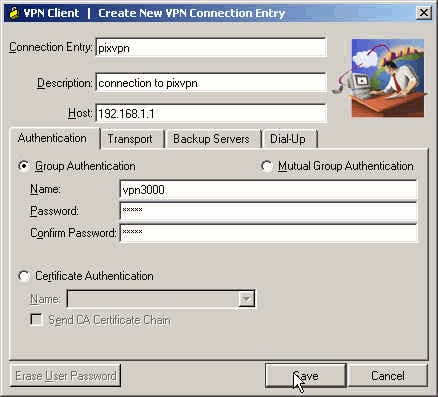
-
En la ventana principal de VPN Client, haga clic en la conexión que desea utilizar y haga clic en el botón Connect.
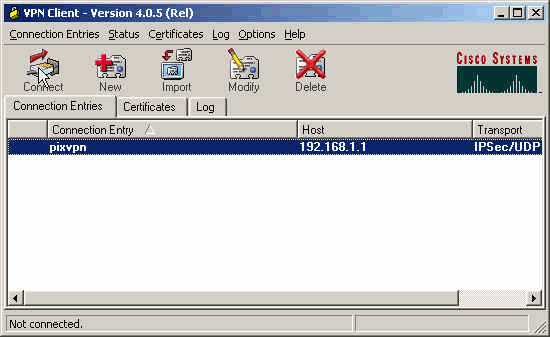
-
Cuando aparezca el mensaje, ingrese la información de su nombre de usuario y contraseña para Xauth y haga clic en OK (Aceptar) para conectarse a la red remota.
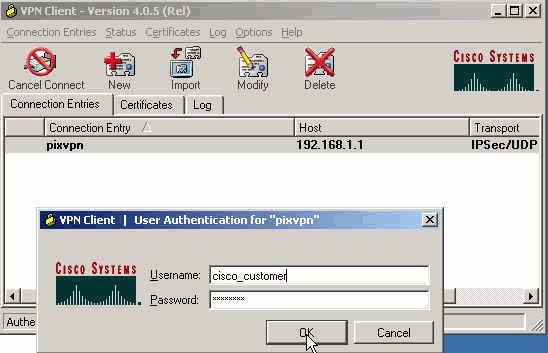
Configuración de VPN Client 3.5
Complete estos pasos para configurar la configuración de VPN Client 3.5.
-
Seleccione Inicio > Programas > Cisco Systems VPN Client > VPN Dialer.
-
Haga clic en Nuevo para iniciar el Asistente de una nueva entrada de conexión.
-
Ingrese el nombre de la nueva entrada de conexión y haga clic en Next (Siguiente).
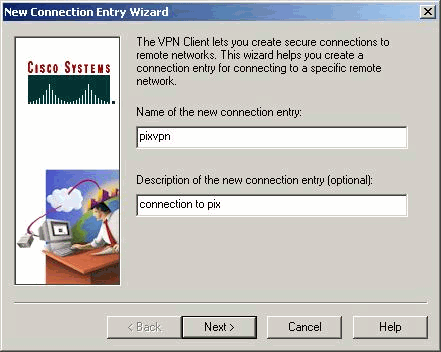
-
Introduzca el nombre de host o la dirección IP del servidor que se utiliza para conectarse al servidor remoto y haga clic en Siguiente.
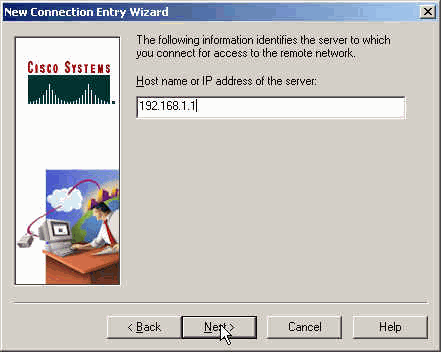
-
Seleccione Group Access Information e introduzca el nombre y la contraseña que se utilizan para autenticar su acceso al servidor remoto. Haga clic en Next (Siguiente).
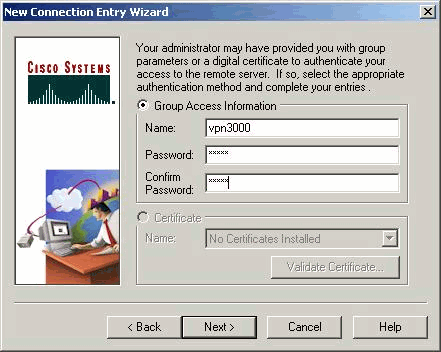
-
Haga clic en Finish (Finalizar) para guardar la nueva entrada.

-
Seleccione la entrada de conexión en el marcador y haga clic en Connect (Conectar).
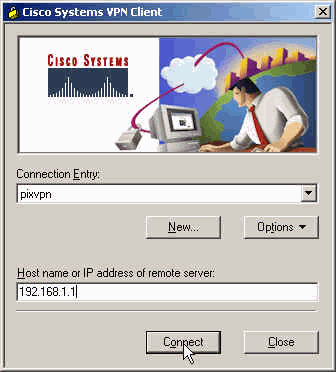
-
Cuando aparezca el mensaje, ingrese la información de su nombre de usuario y contraseña para Xauth y haga clic en OK (Aceptar) para conectarse a la red remota.
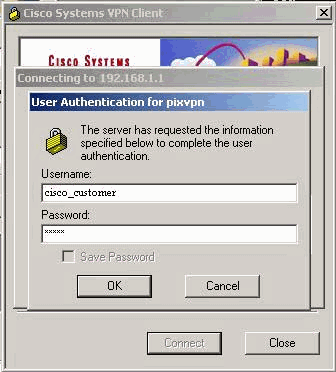
| Configuración de VPN Client 1.1 |
|---|
Network Security policy:
1- TACconn
My Identity
Connection security: Secure
Remote Party Identity and addressing
ID Type: IP subnet
10.89.129.128
255.255.255.128
Port all Protocol all
Connect using secure tunnel
ID Type: IP address
192.168.1.1
Pre-shared Key=cisco1234
Authentication (Phase 1)
Proposal 1
Authentication method: pre-shared key
Encryp Alg: DES
Hash Alg: MD5
SA life: Unspecified
Key Group: DH 1
Key exchange (Phase 2)
Proposal 1
Encapsulation ESP
Encrypt Alg: DES
Hash Alg: MD5
Encap: tunnel
SA life: Unspecified
no AH
2- Other Connections
Connection security: Non-secure
Local Network Interface
Name: Any
IP Addr: Any
Port: All |
Agregar contabilidad
La sintaxis del comando para agregar contabilidad es:
aaa accounting include acctg_service inbound|outbound l_ip l_mask [f_ip f_mask] server_tag
Por ejemplo, en la configuración de PIX, se agrega este comando:
aaa accounting include any inbound 0.0.0.0 0.0.0.0 0.0.0.0 0.0.0.0 AuthInbound
Nota: El comando sysopt connection permit-ipsec, no el comando sysopt ipsec pl-compatible, es necesario para que la contabilidad Xauth funcione. La cuenta Xauth no funciona sólo con el comando sysopt ipsec pl-compatible. La contabilización Xauth es válida para conexiones TCP, no para ICMP o UDP.
Este resultado es un ejemplo de registros de contabilidad TACACS+:
07/27/2004 15:17:54 cisco_customer Default Group 10.89.129.200 stop 15 .. 99 1879 .. .. 0x5 .. PIX 10.89.129.194 telnet 07/27/2004 15:17:39 cisco_customer Default Group 10.89.129.200 start .. .. .. .. .. .. 0x5 .. PIX 10.89.129.194 telnet
Verificación
Use esta sección para confirmar que su configuración funciona correctamente.
La herramienta Output Interpreter Tool (clientes registrados solamente) (OIT) soporta ciertos comandos show. Utilice la OIT para ver un análisis del resultado del comando show.
Nota: Consulte Información Importante sobre Comandos Debug antes de utilizar los comandos debug.
Habilite Cisco Secure Log Viewer para ver las depuraciones del lado del cliente.
-
debug crypto ipsec-Se usa para ver los IPSec Negotiations de la fase 2.
-
debug crypto isakmp—Utilizado para ver las negociaciones ISAKMP para la fase 1.
Troubleshoot
En esta sección encontrará información que puede utilizar para solucionar problemas de configuración. También se muestra un ejemplo de salida del debug .
Comandos para resolución de problemas
La herramienta Output Interpreter Tool (clientes registrados solamente) (OIT) soporta ciertos comandos show. Utilice la OIT para ver un análisis del resultado del comando show.
Nota: Consulte Información Importante sobre Comandos Debug antes de utilizar los comandos debug.
-
debug crypto engine—Utilizado para depurar el proceso del motor de criptografía.
Ejemplo de depuración PIX
pixfirewall#show debug
debug crypto ipsec 1
debug crypto isakmp 1
debug crypto engine
debug fover status
tx Off
rx Off
open Off
cable Off
txdmp Off
rxdmp Off
ifc Off
rxip Off
txip Off
get Off
put Off
verify Off
switch Off
fail Off
fmsg Off
Depuraciones con VPN Client 4.x
pixfirewall#
crypto_isakmp_process_block: src 192.168.1.2, dest 192.168.1.1
VPN Peer: ISAKMP: Added new peer: ip:192.168.1.2
Total VPN Peers:1
VPN Peer: ISAKMP: Peer ip:192.168.1.2 Ref cnt incremented
to:1 Total VPN Peers:1
OAK_AG exchange
ISAKMP (0): processing SA payload. message ID = 0
ISAKMP (0): Checking ISAKMP transform 1 against priority 10 policy
ISAKMP: encryption 3DES-CBC
ISAKMP: hash SHA
ISAKMP: default group 2
ISAKMP: extended auth pre-share
ISAKMP: life type in seconds
ISAKMP: life duration (VPI) of 0x0 0x20 0xc4 0x9b
ISAKMP (0): atts are not acceptable. Next payload is 3
ISAKMP (0): Checking ISAKMP transform 2 against priority 10 policy
ISAKMP: encryption 3DES-CBC
ISAKMP: hash MD5
ISAKMP: default group 2
ISAKMP: extended auth pre-share
ISAKMP: life type in seconds
ISAKMP: life duration (VPI) of 0x0 0x20 0xc4 0x9b
ISAKMP (0): atts are not acceptable. Next payload is 3
ISAKMP (0): Checking ISAKMP transform 3 against priority 10 policy
ISAKMP: encryption 3DES-CBC
ISAKMP: hash SHA
ISAKMP: default group 2
ISAKMP: auth pre-shared
ISAKMP: life type in seconds
ISAKMP: life duration (VPI) of 0x0 0x20 0xc4 0x9b
ISAKMP (0): atts are not acceptable. Next payload is 3
ISAKMP (0): Checking ISAKMP transform 4 against priority 10 policy
ISAKMP: encryption 3DES-CBC
ISAKMP: hash MD5
ISAKMP: default group 2
ISAKMP: auth pre-share
ISAKMP: life type in seconds
ISAKMP: life duration (VPI) of 0x0 0x20 0xc4 0x9b
ISAKMP (0): atts are not acceptable. Next payload is 3
ISAKMP (0): Checking ISAKMP transform 5 against priority 10 policy
ISAKMP: encryption DES-CBC
ISAKMP: hash SHA
ISAKMP: default group 2
ISAKMP: extended auth pre-share
ISAKMP: life type in seconds
ISAKMP: life duration (VPI) of 0x0 0x20 0xc4 0x9b
ISAKMP (0): atts are not acceptable. Next payload is 3
ISAKMP (0): Checking ISAKMP transform 6 against priority 10 policy
ISAKMP: encryption DES-CBC
ISAKMP: hash MD5
ISAKMP: default group 2
ISAKMP: extended auth pre-share
ISAKMP: life type in seconds
ISAKMP: life duration (VPI) of 0x0 0x20 0xc4 0x9b
ISAKMP (0): atts are acceptable. Next payload is 3
!--- Attributes offered by the VPN Client are accepted by the PIX.
ISAKMP (0): processing KE payload. message ID = 0
ISAKMP (0): processing NONCE payload. message ID = 0
ISAKMP (0): processing ID payload. message ID = 0
ISAKMP (0): processing vendor id payload
ISAKMP (0): processing vendor id payload
ISAKMP (0): remote peer supports dead peer detection
ISAKMP (0): processing vendor id payload
ISAKMP (0): speaking to a Unity client
ISAKMP (0): ID payload
next-payload: 10
type : 1
protocol : 17
port : 500
length : 8
ISAKMP (0) : Total payload length: 12
return status is IKMP_NO_ERROR
crypto_isakmp_process_block: src 192.168.1.2, dest 192.168.1.1 OAK_AG exchange
ISAKMP (0): processing HASH payload. message ID = 0
ISAKMP (0): processing NOTIFY payload 24578 protocol 1
spi 0, message ID = 0
ISAKMP (0): processing notify INITIAL_CONTACT
IPSEC(key_engine): got a queue event...
IPSEC(key_engine_delete_sas): rec'd delete notify from ISAKMP
IPSEC(key_engine_delete_sas): delete all SAs
shared with 192.168.1.2
ISAKMP (0): SA has been authenticated
return status is IKMP_NO_ERROR
ISAKMP/xauth: request attribute XAUTH_TYPE
ISAKMP/xauth: request attribute XAUTH_USER_NAME
ISAKMP/xauth: request attribute XAUTH_USER_PASSWORD
ISAKMP (0:0): initiating peer config to 192.168.1.2.
ID = 1623347510 (0x60c25136) crypto_isakmp_process_block: src 192.168.1.2,
dest 192.168.1.1
ISAKMP_TRANSACTION exchange
ISAKMP (0:0): processing transaction payload
from 192.168.1.2. message ID = 84
ISAKMP: Config payload CFG_REPLY
return status is IKMP_ERR_NO_RETRANS
ISAKMP (0:0): initiating peer config to 192.168.1.2.
ID = 2620656926 (0x9c340d1e) crypto_isakmp_process_block: src 192.168.1.2,
dest 192.168.1.1
ISAKMP_TRANSACTION exchange
ISAKMP (0:0): processing transaction payload
from 192.168.1.2. message ID = 60
ISAKMP: Config payload CFG_ACK
return status is IKMP_NO_ERROR
crypto_isakmp_process_block: src 192.168.1.2, dest 192.168.1.1
ISAKMP_TRANSACTION exchange
ISAKMP (0:0): processing transaction payload
from 192.168.1.2. message ID = 0
ISAKMP: Config payload CFG_REQUEST
ISAKMP (0:0): checking request:
ISAKMP: attribute IP4_ADDRESS (1)
ISAKMP: attribute IP4_NETMASK (2)
ISAKMP: attribute IP4_DNS (3)
ISAKMP: attribute IP4_NBNS (4)
ISAKMP: attribute ADDRESS_EXPIRY (5)
Unsupported Attr: 5
ISAKMP: attribute APPLICATION_VERSION (7)
Unsupported Attr: 7
ISAKMP: attribute UNKNOWN (28672)
Unsupported Attr: 28672
ISAKMP: attribute UNKNOWN (28673)
Unsupported Attr: 28673
ISAKMP: attribute UNKNOWN (28674)
ISAKMP: attribute UNKNOWN (28676)
ISAKMP: attribute UNKNOWN (28679)
Unsupported Attr: 28679
ISAKMP: attribute UNKNOWN (28680)
Unsupported Attr: 28680
ISAKMP: attribute UNKNOWN (28677)
Unsupported Attr: 28677
ISAKMP (0:0): responding to peer config from 192.168.1.2. ID = 177917346
return status is IKMP_NO_ERROR
crypto_isakmp_process_block: src 192.168.1.2, dest 192.168.1.1
OAK_QM exchange
oakley_process_quick_mode:
OAK_QM_IDLE
ISAKMP (0): processing SA payload. message ID = 942875080
ISAKMP : Checking IPSec proposal 1
ISAKMP: transform 1, ESP_3DES
ISAKMP: attributes in transform:
ISAKMP: authenticator is HMAC-MD5
ISAKMP: encaps is 1
ISAKMP: SA life type in seconds
ISAKMP: SA life duration (VPI) of 0x0 0x20 0xc4 0x9b
IPSEC(validate_proposal): transform
proposal (prot 3, trans 3, hmac_alg 1) not supported
ISAKMP (0): atts not acceptable. Next payload is 0
ISAKMP (0): skipping next ANDed proposal (1)
ISAKMP : Checking IPSec proposal 2
ISAKMP: transform 1, ESP_3DES
ISAKMP: attributes in transform:
ISAKMP: authenticator is HMAC-SHA
ISAKMP: encaps is 1
ISAKMP: SA life type in seconds
ISAKMP: SA life duration (VPI) of 0x0 0x20 0xc4 0x9b
IPSEC(validate_proposal): transform
proposal (prot 3, trans 3, hmac_alg 2) not supported
ISAKMP (0): atts not acceptable. Next payload is 0
ISAKMP (0): skipping next ANDed proposal (2)
ISAKMP: Checking IPSec proposal 3
ISAKMP: transform 1, ESP_3DES
ISAKMP: attributes in transform:
ISAKMP: authenticator is HMAC-MD5
ISAKMP: encaps is 1
ISAKMP: SA life type in seconds
ISAKMP: SA life duration (VPI) of 0x0 0x20 0xc4 0x9b
IPSEC(validate_proposal): transform
proposal (prot 3, trans 3, hmac_alg 1) not supported
ISAKMP (0): atts not acceptable. Next payload is 0
ISAKMP: Checking IPSec proposal 4
ISAKMP: transform 1, ESP_3DES
ISAKMP: attributes in transform:
ISAKMP: authenticator is HMAC-SHA
ISAKMP: encaps is 1
ISAKMP: SA life type in seconds
ISAKMP: SA life duration (VPI) of 0x0 0x20 0xc4 0x9b
IPSEC(validate_proposal): transform
proposal (prot 3, trans 3, hmac_alg 2) not supported
ISAKMP (0): atts not acceptable. Next payload is 0
ISAKMP : Checking IPSec proposal 5
ISAKMP: transform 1, ESP_DES
ISAKMP: attributes in transform:
ISAKMP: authenticator is HMAC-MD5
ISAKMP: encaps is 1
ISAKMP: SA life type in seconds
ISAKMP: SA life duration (VPI) of 0x0 0x20 0xc4 0x9b
ISAKMP (0): atts are acceptable.
ISAKMP (0): bad SPI size of 2 octets!
ISAKMP: Checking IPSec proposal 6
ISAKMP: transform 1, ESP_DES
ISAKMP: attributes in transform:
ISAKMP: authenticator is HMAC-SHA
ISAKMP: encaps is 1
ISAKMP: SA life type in seconds
ISAKMP: SA life duration (VPI) of 0x0 0x20 0xc4 0x9b
IPSEC(validate_proposal): transform
proposal (prot 3, trans 2, hmac_alg 2) not supported
ISAKMP (0): atts not acceptable. Next payload is 0
ISAKMP (0): skipping next ANDed proposal (6)
ISAKMP : Checking IPSec proposal 7
ISAKMP: transform 1, ESP_DES
ISAKMP: attributes in transform:
ISAKMP: authenticator is HMAC-MD5
ISAKMP: encaps is 1
ISAKMP: SA life type in seconds
ISAKMP: SA life duration (VPI) of 0x0 0x20 0xc4 0x9b
ISAKMP (0): atts are acceptable.IPSEC(validate_proposal_request):
proposal part #1,
(key eng. msg.) dest= 192.168.1.1, src=
192.168.1.2,
dest_proxy= 192.168.1.1/255.255.255.255/0/0 (type=1),
src_proxy= 10.89.129.200/255.255.255.255/0/0 (type=1),
protocol= ESP, transform= esp-des esp-md5-hmac ,
lifedur= 0s and 0kb,
spi= 0x0(0), conn_id= 0, keysize= 0, flags= 0x4
ISAKMP (0): processing NONCE payload. message ID = 942875080
ISAKMP (0): processing ID payload. message ID = 942875080
ISAKMP (0): ID_IPV4_ADDR src 10.89.129.200 prot 0 port 0
ISAKMP (0): processing ID payload. message ID = 942875080
ISAKMP (0): ID_IPV4_ADDR dst 192.168.1.1 prot 0
port 0IPSEC(key_engine): got a queue event...
IPSEC(spi_response): getting spi 0x64d7a518(1691854104) for SA
from 192.168.1.2 to 192.168.1.1 for prot 3
return status is IKMP_NO_ERROR
crypto_isakmp_process_block: src 192.168.1.2, dest 192.168.1.1
OAK_QM exchange
oakley_process_quick_mode:
OAK_QM_IDLE
ISAKMP (0): processing SA payload. message ID = 3008609960
ISAKMP: Checking IPSec proposal 1
ISAKMP: transform 1, ESP_3DES
ISAKMP: attributes in transform:
ISAKMP: authenticator is HMAC-MD5
crypto_isakmp_process_block: src 192.168.1.2, dest 192.168.1.1
OAK_QM exchange
oakley_process_quick_mode:
OAK_QM_AUTH_AWAITmap_alloc_entry: allocating entry 2
map_alloc_entry: allocating entry 1
ISAKMP (0): Creating IPSec SAs
inbound SA from 192.168.1.2 to 192.168.1.1
(proxy 10.89.129.200 to 192.168.1.1)
has spi 1691854104 and conn_id 2 and flags 4
lifetime of 2147483 seconds
outbound SA from 192.168.1.1 to 192.168.1.2
(proxy 192.168.1.1 to 10.89.129.200)
has spi 1025193431 and conn_id 1 and flags 4
lifetime of 2147483 seconds
IPSEC(key_engine): got a queue event...
IPSEC(initialize_sas): ,(key eng. msg.) dest= 192.168.1.1, src= 192.168.1.2,
dest_proxy= 192.168.1.1/0.0.0.0/0/0 (type=1),
src_proxy= 10.89.129.200/0.0.0.0/0/0 (type=1),
protocol= ESP, transform= esp-des esp-md5-hmac ,
lifedur= 2147483s and 0kb,
spi= 0x64d7a518(1691854104),conn_id= 2, keysize= 0, flags= 0x4
IPSEC(initialize_sas): ,
(key eng. msg.) src= 192.168.1.1, dest=192.168.1.2,
src_proxy= 192.168.1.1/0.0.0.0/0/0 (type=1),
dest_proxy= 10.89.129.200/0.0.0.0/0/0 (type=1),
protocol= ESP, transform=esp-des esp-md5-hmac ,
lifedur= 2147483s and 0kb,
spi= 0x3d1b35d7(1025193431),conn_id= 1, keysize= 0, flags= 0x4
VPN Peer: IPSEC: Peer ip:192.168.1.2 Ref cnt incremented to:2 Total VPN Peers:1
VPN Peer: IPSEC: Peer ip:192.168.1.2 Ref cnt incremented to:3 Total VPN Peers:1
return status is IKMP_NO_ERROR
crypto_isakmp_process_block: src 192.168.1.2, dest 192.168.1.1
OAK_QM exchange
oakley_process_quick_mode:
OAK_QM_AUTH_AWAITmap_alloc_entry: allocating entry 4
map_alloc_entry: allocating entry 3
ISAKMP (0): Creating IPSec SAs
inbound SA from 192.168.1.2 to 192.168.1.1 (proxy 10.89.129.200 to 0.0.0.0)
has spi 3415657865 and conn_id 4 and flags 4
lifetime of 2147483 seconds
outbound SA from 192.168.1.1 to 192.168.1.2 (proxy 0.0.0.0 to 10.89.129.200)
has spi 2383969893 and conn_id 3 and flags 4
lifetime of 2147483 secondsIPSEC(key_engine): got a queue event...
IPSEC(initialize_sas): ,
(key eng. msg.) dest= 192.168.1.1, src=192.168.1.2,
dest_proxy= 0.0.0.0/0.0.0.0/0/0 (type=4),
src_proxy= 10.89.129.200/0.0.0.0/0/0 (type=1),
protocol= ESP, transform=esp-des esp-md5-hmac ,
lifedur= 2147483s and 0kb,
spi= 0xcb96cd89(3415657865),conn_id= 4, keysize= 0, flags= 0x4
IPSEC(initialize_sas): ,
(key eng. msg.) src= 192.168.1.1, dest=192.168.1.2,
src_proxy= 0.0.0.0/0.0.0.0/0/0 (type=4),
dest_proxy= 10.89.129.200/0.0.0.0/0/0 (type=1),
protocol= ESP, transform=esp-des esp-md5-hmac ,
lifedur= 2147483s and 0kb,
spi= 0x8e187e65(2383969893),conn_id= 3, keysize= 0, flags= 0x4
VPN Peer: IPSEC: Peer ip:192.168.1.2 Ref cnt incremented
to:4 Total VPN Peers:1
VPN Peer: IPSEC: Peer ip:192.168.1.2 Ref cnt incremented
to:5 Total VPN Peers:1
return status is IKMP_NO_ERROR
pixfirewall#show uauth
Current Most Seen
Authenticated Users
1 1
Authen In Progress
0 1
ipsec user 'cisco_customer' at 10.89.129.200, authenticated
pixfirewall#
Depuraciones con el cliente VPN 1.1
crypto_isakmp_process_block: src 192.168.1.3, dest 192.168.1.1
VPN Peer: ISAKMP: Added new peer: ip:192.168.1.3
Total VPN Peers:1
VPN Peer: ISAKMP: Peer ip:192.168.1.3 Ref cnt incremented to:1
Total VPN Peers:1
OAK_MM exchange
ISAKMP (0): processing SA payload. message ID = 0
ISAKMP (0): Checking ISAKMP transform 1 against priority 10 policy
encryption DES-CBC
ISAKMP: hash MD5
ISAKMP: default group 1
ISAKMP: auth pre-share
ISAKMP (0): atts are not acceptable. Next payload is 0
ISAKMP (0): Checking ISAKMP transform 1 against priority 20 policy
ISAKMP: encryption DES-CBC
ISAKMP: hash MD5
ISAKMP: default group 1
ISAKMP: auth pre-share
ISAKMP (0): atts are acceptable. Next payload is 0
ISAKMP (0): SA is doing pre-shared key authentication
using id type ID_IPV4_ADDR
return status is IKMP_NO_ERROR
crypto_isakmp_process_block: src 192.168.1.3, dest 192.168.1.1
OAK_MM exchange
ISAKMP (0): processing KE payload. message ID = 0
ISAKMP (0): processing NONCE payload. message ID = 0
ISAKMP (0): processing vendor id payload
ISAKMP (0): processing vendor id payload
return status is IKMP_NO_ERROR
crypto_isakmp_process_block: src 192.168.1.3, dest 192.168.1.1
OAK_MM exchange
ISAKMP (0): processing ID payload. message ID = 0
ISAKMP (0): processing HASH payload. message ID = 0
ISAKMP (0): processing NOTIFY payload 24578 protocol 1
spi 0, message ID = 0
ISAKMP (0): SA has been authenticated
ISAKMP (0): ID payload
next-payload : 8
type : 1
protocol : 17
port : 500
length : 8
ISAKMP (0): Total payload length: 12
return status is IKMP_NO_ERROR
crypto_isakmp_process_block: src 192.168.1.3, dest 192.168.1.1
ISAKMP: Created a peer node for 192.168.1.3
OAK_QM exchange
ISAKMP (0:0): Need XAUTH
ISAKMP/xauth: request attribute XAUTH_TYPE
ISAKMP/xauth: request attribute XAUTH_USER_NAME
ISAKMP/xauth: request attribute XAUTH_USER_PASSWORD
ISAKMP (0:0): initiating peer config to 192.168.1.3.
ID = 3196940891 (0xbe8d725b)
return status is IKMP_NO_ERROR
crypto_isakmp_process_block: src 192.168.1.3, dest 192.168.1.1
ISAKMP_TRANSACTION exchange
ISAKMP (0:0): processing transaction payload
from 192.168.1.3. message ID = 84
ISAKMP: Config payload CFG_REPLY
return status is IKMP_ERR_NO_RETRANS
ISAKMP (0:0): initiating peer config to 192.168.1.3.
ID = 3196940891 (0xbe8d725b)
crypto_isakmp_process_block: src 192.168.1.3, dest 192.168.1.1
ISAKMP_TRANSACTION exchange
ISAKMP (0:0): processing transaction payload
from 192.168.1.3. message ID = 60
ISAKMP: Config payload CFG_ACK
ISAKMP (0:0): initiating peer config to 192.168.1.3.
ID = 1647424595 (0x6231b453)
return status is IKMP_NO_ERROR
crypto_isakmp_process_block: src 192.168.1.3, dest 192.168.1.1
ISAKMP_TRANSACTION exchange
ISAKMP (0:0): processing transaction payload
from 192.168.1.3. message ID = 60
ISAKMP: Config payload CFG_ACK
ISAKMP (0:0): peer accepted the address!
return status is IKMP_NO_ERROR
crypto_isakmp_process_block: src 192.168.1.3, dest 192.168.1.1
OAK_QM exchange
oakley_process_quick_mode:
OAK_QM_IDLE
ISAKMP (0): processing SA payload. message ID = 802013669
ISAKMP : Checking IPSec proposal 1
ISAKMP: transform 1, ESP_DES
ISAKMP: attributes in transform:
ISAKMP: authenticator is HMAC-MD5
ISAKMP: encaps is 1
ISAKMP (0): atts are acceptable.IPSEC(validate_proposal_request)
:proposal part #1,
(key eng. msg.) dest= 192.168.1.1, src = 192.168.1.3,
dest_proxy= 10.89.129.128/255.255.255.128/0/0 (type=4),
src_proxy= 10.89.129.200/255.255.255.255/0/0 (type=1),
protocol= ESP, transform=esp-des esp-md5-hmac ,
lifedur= 0s and 0kb,
spi= 0x0(0), conn_id= 0, keysize=0, flags= 0x4
ISAKMP (0): processing NONCE payload. message ID = 802013669
ISAKMP (0): processing ID payload. message ID = 802013669
ISAKMP (0): ID_IPV4_ADDR src 10.89.129.200 prot 0 port 0
ISAKMP (0): processing ID payload. message ID = 802013669
ISAKMP (0): ID_IPV4_ADDR_SUBNET dst 10.89.129.128/255.255.255.128
prot 0 port 0IPSEC(key_engine): got a queue event...
IPSEC(spi_response): getting spi 0xd7cef5ba(3620664762)for SA
from 192.168.1.3 to 192.168.1.1 for prot 3
return status is IKMP_NO_ERROR
crypto_isakmp_process_block: src 192.168.1.3, dest 192.168.1.1
OAK_QM exchange
oakley_process_quick_mode:
OAK_QM_AUTH_AWAITmap_alloc_entry: allocating entry 1
map_alloc_entry: allocating entry 2
ISAKMP (0): Creating IPSec SAs
inbound SA from 192.168.1.3 to 192.168.1.1
(proxy 10.89.129.200 to 10.89.129.128)
has spi 3620664762 and conn_id 1 and flags 4
outbound SA from 192.168.1.1 to 192.168.1.3
(proxy 10.89.129.128 to 10.89.129.200)
has spi 541375266 and conn_id 2 and flags 4
IPSEC(key_engine): got a queue event...
IPSEC(initialize_sas): ,
(key eng. msg.) dest= 192.168.1.1, src=192.168.1.3,
dest_proxy= 10.89.129.128/255.255.255.128/0/0 (type=4),
src_proxy= 10.89.129.200/0.0.0.0/0/0 (type=1),
protocol= ESP, transform=esp-des esp-md5-hmac ,
lifedur= 0s and 0kb,
spi= 0xd7cef5ba(3620664762),conn_id= 1, keysize= 0, flags= 0x4
IPSEC(initialize_sas): ,
(key eng. msg.) src= 192.168.1.1, dest=192.168.1.3,
src_proxy= 10.89.129.128/255.255.255.128/0/0 (type=4),
dest_proxy= 10.89.129.200/0.0.0.0/0/0 (type=1),
protocol= ESP, transform=esp-des esp-md5-hmac ,
lifedur= 0s and 0kb,
spi= 0x2044bb22(541375266),conn_id= 2, keysize= 0, flags= 0x4
VPN Peer: IPSEC: Peer ip:192.168.1.3 Ref cnt incremented
to:2 Total VPN Peers:1
VPN Peer: IPSEC: Peer ip:192.168.1.3 Ref cnt incremented
to:3 Total VPN Peers:1
return status is IKMP_NO_ERROR
Información Relacionada
Historial de revisiones
| Revisión | Fecha de publicación | Comentarios |
|---|---|---|
1.0 |
26-Sep-2008 |
Versión inicial |
Contacte a Cisco
- Abrir un caso de soporte

- (Requiere un Cisco Service Contract)
 Comentarios
Comentarios